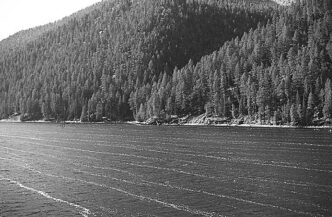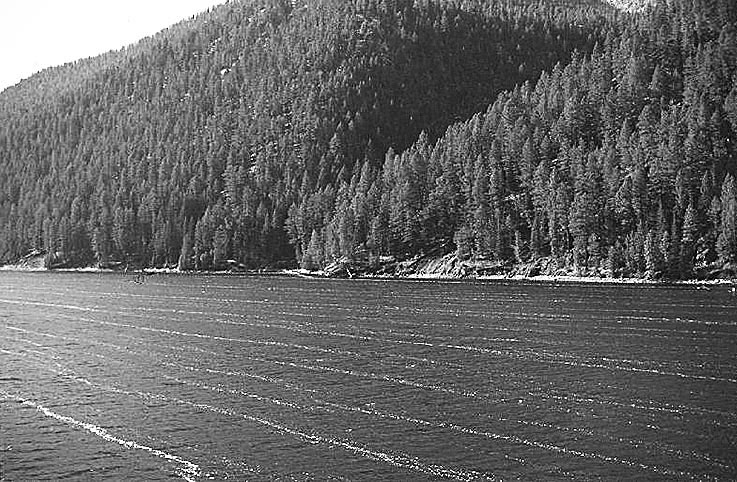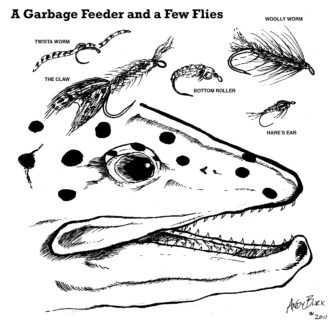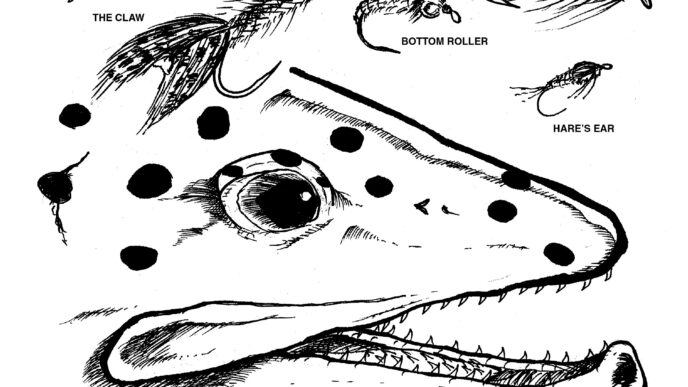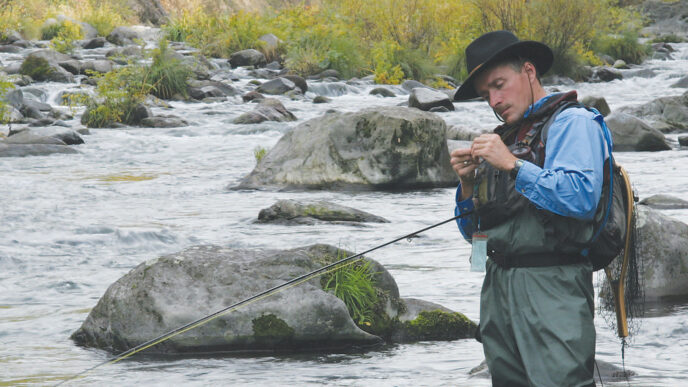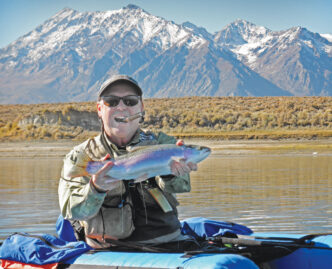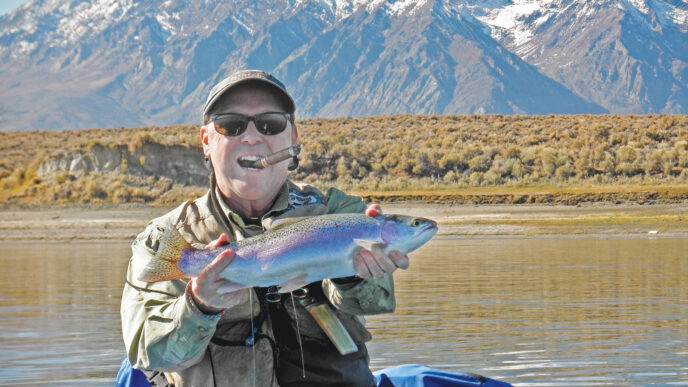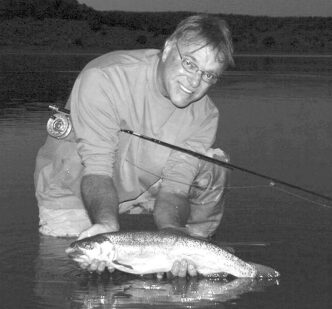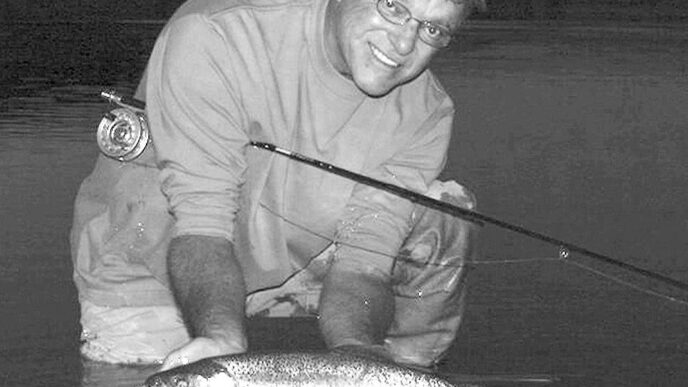Fishing in the wind is like judo: if you know how to use its energy on your behalf, then the stronger the wind, the greater your benefit. In our flyfishing school, the best casting classes have occurred during strong blows, when students get to turn theory into practice. At the end of the day, they walk away confident in their ability to master any weather condition short of a hurricane — maybe a little too confident.
Casting with the wind is a no-brainer. Make big loops and let the wind carry the line. Roll and snap-T casts are excellent because you don’t need to back cast into the wind, and the forward loop gets carried away, literally.
Casting into the wind is a bit more problematic. A normal back-and-forth cast results in an accelerated load on the back cast and frequently a weak, tangled mess on the forward cast. This is so easy to correct and so much fun to do, I’m amazed the “into-the-wind cast” isn’t in everyone’s standard repertoire. I’m sure it is in a video or book somewhere and has a proper name — I just haven’t looked hard enough to find it. A steeple cast on steroids might be an appropriate way to describe it.
An into-the-wind cast starts with flipping the line up into the air, never behind you. Up! The rod tip stops when poking straight into the sky. Don’t let it drift behind the vertical position a single inch. With your rod tip straight up, the wind will carry the line behind you like a flag. Turn your head and watch the line straighten. The instant before it starts to fall toward the ground, drive the rod down like a hatchet cleaving hard oak. Don’t extend the arm — bring your forearm down in a chopping fashion. Stop (not just “stop”) the rod tip about three inches from the ground.
If you do this right and don’t allow the rod tip to drift back past the vertical, it is impossible to throw a tailing loop or tie a wind knot, because the rod is always falling away from the line. When you stop the rod at ground level, all of its energy is tightly focused forward. The result will be a fly line creating a very tight wedge that shoots out just above the water. The stronger the wind, the more load the wind will put on your “flagging” line, and the more powerful the cast. Because the line is punching out close to the surface of the water, it takes advantage of the ground effect, which substantially reduces the force of the wind through which the line has to cut. It is a fantastic cast that can be used anywhere there is room to let your line get carried backward by the wind.
Another extremely useful windy-day cast is a sidearm water haul. Instead of pulling the line up and out of the water in the usual fashion, pull it sideways. Put the rod tip on the water and point it down current until the line is taut. Roll your hand (with reel) so the palm is facing the sky. Keeping your palm skyward and forearm nearly parallel with the water, smoothly pull the line off the water in a motion similar to pulling a sword from a scabbard. When only a few feet of fly line are left on the water snap your wrist upstream with the exact same motion, power, and intensity you would use to drill a Frisbee up and across the river. The water haul is powerful, and like the into-the-wind cast, it keeps the line in the quiet air just above the water.
When fishing still waters, anglers invariably cast with the wind, because they mistakenly believe it is easier. With streamers, this is OK, but with dry flies, it is the kiss of death. Drag is just as important on lakes as it is on rivers and streams. The natural bugs on the surface of the lake are being pushed downwind. If your cast is downwind, the fly is instantly tethered to a taut line, and drag, relative to the drift of the naturals, is immediate. A much better bet is to cast into the wind and allow your bug to drift inbound alongside its living relatives.
Wind makes figuring out the location of lake-borne trout easy. In calm conditions, trout routinely feed in large circular patterns or figure eights. When a fish rises, it is all but impossible to guess in which direction it is swimming. When the wind picks up, the trout start rising into the wind, rather than making a loop. The stiffer the wind, the straighter the line in which the trout is going to feed. Simply cast upwind of the last rise.
In particularly stiff winds, you’ll see rows of foam develop on the water’s surface. These are called Langmuir bands and should be considered a gift from God. As the wind moves over the lake, it pushes down the water and squeezes it sideways at about 15 degrees from the direction of the wind. This lane of squished water collides with parallel lanes of equally squished water, which collide with their neighbors, and so on. Pretty soon, these collision lanes recirculate the water over and over until it turns the various particles in the water into a foamy, soapy broth. This broth is a strong surfactant that traps, drowns, and collects any bug foolish enough to be on the water. To the bugs, it is a killing field, but to the fish, it is party time in the end zone. Fish these foamy tracks, cast upwind of any rising fish, and you’ll be a rock star. As wind develops, it sets up a very thin, but very fierce shear zone between the water at the surface and the still water a millimeter below. The veneer of surface water slides across the still water and does a Maytag on any insect caught in the shear zone. I have seen literally hundreds of Callibaetis nymphs at a time holding in the film in various states of emergence, when a gust of wind blows through and sets the entire hatch to spinning, tumbling, then sinking helplessly to their death. The feeding frenzy that ensues among the fish is hilarious, yet few anglers are aware it is taking place, because most of the bugs are eaten several inches to a foot or so below the surface, and the trout give little clue to their gluttonous presence.
When wind-driven waves strike the shoreline of a lake, several things occur. The wind-pushed water strikes the shore, then bounces back into the lake. These reflecting waves collide with the wind-driven waves and set up a zone of equilibrium. This zone traps flotsam being carried shoreward by the wind, as well as items of food that might arrive from shore or be unearthed as the wind-driven currents excavate the nearshore substrate.
If these waves are slap-ping at a cliff face, erosion can be severe, with a bounty of food unearthed. Lisa and I encountered exactly this phenomenon during a windy spring day on Bullard’s Bar Reservoir as we were hunting carp. The carp were not in the protected coves or on the flats behind submerged island tops, as we expected. We finally found fish feeding in the slap zone at the base of the bright-red cliffs on the downwind end of the lake.
When fishing a lake from a boat or pontoon, it is nice to have two anchors. I like to have one anchor that holds the craft firmly in place and a second anchor, such as a length of chain, that can be adjusted to hold steady or to allow a subtle drift. Drop the bow anchor first and let the boat pull taut to the line against the wind before deploying the stern anchor. If the stern anchor is set prematurely, the bow will be slightly off from the wind, and hull slap, especially on an aluminum boat, will drive you nuts and probably spook some fish.With anchors set correctly, the boat will provide a solid fishing platform, even in a brisk wind.
One of the deadliest retrieves, especially when imitating chironomid larvae and pupae, is a smooth, steady upward draw. This is difficult to do correctly without wind. With wind, it is a piece of cake. Cast into the wind, allow the imitation (I like Brassies for weight and Zebra Pupas for flash) to sink into the zone, then simply give your line a single mend across the wind. As the breeze-driven waves push the belly of your line, it creates the perfect smooth rise of the fly. On this taut line, fish normally hook themselves.
A trick shown to me decades ago bymaster angler Joe Heuseveldt for fishing Martis Lake during the inevitable afternoon Truckee winds is to skip the fly over the tops of the waves. He would take something like a damsel fly dry on a long leader and hold the rod in the air. The line would be held high by the wind, and he would direct the damsel like a puppeteer so that it would touch down on a wave top, then lift into the air until the next wave. This dapping technique drives trout nuts. Often they will launch clear of the water when taking the fly.
A close cousin to Joe’s technique is the ancient art of skating spiders in the wind. A spider is nothing more than four to eight oversized hackle feathers wound in opposing directions on a hook so they form a tight, stiff knot. With a long leader and the rod held high, the spider is skated across the slick water of tailouts, pools, and pockets. A good wind helps to loft the fly and give it action. Trout and smallmouths love it, and if craneflies have been flying low over the water, scratching eggs out of their abdomens, it will absolutely match the hatch.
Finally, it goes without saying that in windy conditions, terrestrials should be your number-one choice. Especially late in the summer and in the fall, when most of the aquatic bugs are miniscule, ants, beetles, grasshoppers, yellow jackets, and the like are at the top of the piscine grocery lists. When it’s windy, trout will hold so tight to the bank that their backs will sometimes be out of the water. The first one in the terrestrial chow lines gets the rewards. It also gets your fly.



